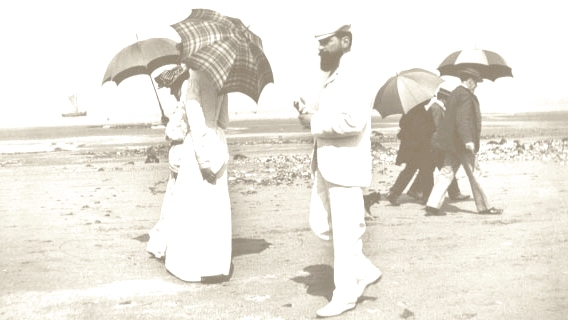Boynton links I like, who in turn links Emily Bowling, photographer.
Bowling's biography mentions her restoring stained glass at WHITEWAY & WALDRON Ltd, purveyors of religious antiques, who have now become Graham Kirkland, "A real shop in London full of religious antiques and second hand church items". Under miscellaneous they proffer such desirables as this lectern
this sanctuary lamp
this relic - "'From the column of the Flagellation of Jesus Christ'. No cert."
also these bells, rung by the altar boy at key moments during the Catholic Mass, one of whom I was myself, in the past.
The ones I learned to ring were four in number, rather than three as here, and all of a golden hue.
I was very good at ringing them.
Also W&W/GK offer this tabor for sale.
Tabor being an unfamiliar term, outside the percussive, I launched the google bar for images thereof and discovered
this image upon which I refuse to comment.
Also this site of postcards from early 19th c. McHenry Co. Illinois.
The Tabor house therein is evocative, I've lived in more than one like it, and my dreams hold townsful.
This google-returned image, Baby Doe's cabin, piqued my interest, and the site it led to as well.
Baby Doe, at her cabin.
And led to the following excerpts:
When Horace built a palatial mansion in Denver, she refused to live upstairs in the master bedroom, instead preferring the servants quarters next to the kitchen. She also kept a cow tethered to the front door, which she insisted on milking herself. Horace, who by then had been made the Lieutenant Governor of the state, was embarrassed. He wanted to live in a style befitting his station, but Augusta only scoffed at such statements.
[...]
With all the tension at home, Tabor's eyes began to stray. His newfound wealth and power brought him much attention, and he loved to spend money on beautiful women and lavish them with gifts. In a chance meeting at the old "Saddle Rock Cafe" in 1880, the "Silver King", for which he was by then known, met the beautiful Elizabeth McCourt "Baby" Doe, and both of their lives would change forever
[...]
On the lawn outside the mansion, a hundred peacocks strutted and the landscape was adorned with more controversial decorations, which included some nude statues that so further offended Baby's highly proper female neighbors. In response, the highly spirited Baby Doe had her dressmaker come in and make dresses for the statues.
[...]
The fairytale ended in 1893, when the country moved to the gold standard. Silver, Horace's main holding, along with parcels of highly mortgaged property came crashing down, along with the Tabors' lifestyle. Horace, failing to listen to the advice of others and diversify, faced ruin. In the interim, and adding to the crisis, Tabor had also made a number of unsuccessful, if not unwise, investments in foreign mining ventures that failed. He lost huge amounts of money in Mexico and South America.
[...]
Still beautiful and relatively young, Baby Doe could easily have remarried. She chose, instead, to "hold on to the Matchless," continuously seeking funds to "work" it. With her two children in tow, Baby returned to Leadville and took up residence in the one-room, 12 by 16-foot structure that originally served as a tool shed at the Matchless Mine. Her elder daughter, 15-year-old Lillie, so resented the place, she boldly stated that she was leaving, and borrowing the money for the train fare from her uncle, she went to Wisconsin to live with her grandmother, ceasing all contact with her mother and sister.
[...]
Baby Doe was living in the tiny cabin only due to the generosity of the current owners of the worthless mine, where she scribbled page after page of her increasingly paranoiac and, ultimately delirious thoughts.
As years passed, Baby, with no income and unable to buy anything, would rap her feet in burlap sacks held with twine. When sick, she would doctor herself with turpentine and lard. With the help of creditors and through the kindness of her Leadville neighbors, she was supplied with the bare necessities of life.
[...]
Baby Doe's later life is represented by a worn leather satchel that sits in the corner of the room and appears in a photo taken only a few years before she died. Her most prized possession was a framed statue of the Virgin Mary, which hangs on the wall above a narrow, quilt-covered bed.
Baby Doe, who turned to religion and a sort of mysticism as time went by and her isolation grew, also used a calendar on display to keep track of the dates on which she said she communed with spirit voices.
And thus the small circle completes.



